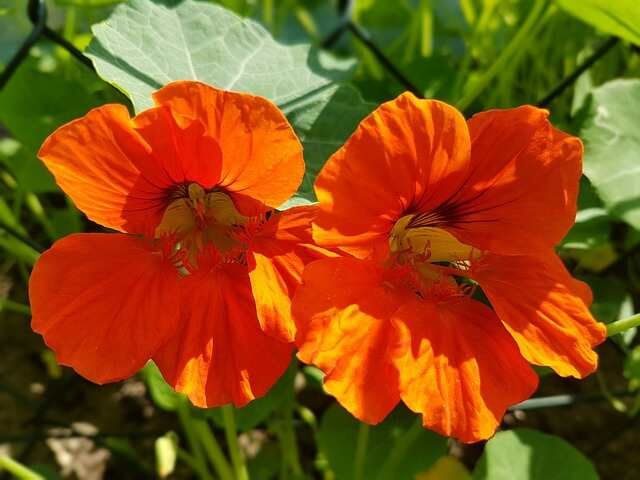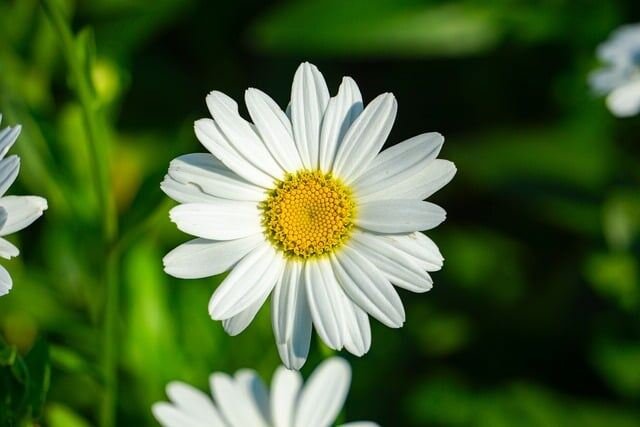What’s going on, gardeners? on today’s article, I’m going to share with you four flowers that you can plant around your garden that naturally repel insects when planted properly. I’ll also explain how to plant them properly to avoid disaster, and I’ll share one common flower that is often said should be planted around your garden but that I will never grow again.
One thing I’ve been doing with great success for years is interplanting my pest-susceptible vegetables with alliums (onions, garlic, leeks, and shallots) because the natural scent of alliums repels pests. However, there’s been a problem with that. The problem is that I harvest most of my alliums, so they do a great job at preventing pest damage on my really pest-susceptible plants in late spring. But then I pull them out of my garden, and the most extreme insect damagethat, once the alliums have already been harvested. So, I have my worst insect pest pressure in my garden, and the alliums are no longer anywhere to be found.
Luckily, alliums are not the only plants out there that naturally repel pests. There are lots of flowers out there that also have pest-repellent properties that you can interplant within your pest-susceptible vegetables that will repel pests all summer long. They will also have the added benefit of bringing in beneficial insects like pollinators into your garden.
Flower #1: Sunflower

The first flower that can help you control insect pests in your garden is one I’ve been using for years with great success, and that is the sunflower. The sunflower is an amazing flower that can help you control insect pest outbreaks in your garden. However, it’s not their pest-repellent properties that make the sunflower so valuable but rather their ability to attract certain pests that makes them so valuable.
I’ve been planting the variety ‘Peredovic’ sunflower in my garden for years now as a means of insect control, and it has worked fantastic at keeping certain pests off of my plants. For whatever reason, Peredovic sunflowers are extremely attractive to shield bugs, leaf-footed bugs, and stink bugs, especially leaf-footed bugs, which are a huge problem in my garden. Now, the way this works is you would not want to interplant this variety inside your garden because it would attract these pests into your garden. Instead, you plant it as a distraction crop, planting it nearby your garden but on the outskirts. That way, it attracts all of the pests to the sunflowers instead of inside your garden. Because they love this flower so much, the bugs will attack this flower instead of your plants because it is the bug’s favorite thing.
Now, will this work with other varieties of sunflower that are not ‘Peredovic’? Possibly. I’m not entirely sure, but I have heard and read studies that show that this is one of the most effective varieties, and it has worked well for me. So, I suggest you buy this exact variety to test it out.
Here is how I use the sunflower to my advantage. What I do is I plant the ‘Peredovic’ sunflower outside of my garden in this bed right here, outside of the fence. What that tends to do is it draws all of the leaf-footed bugs, shield bugs, and stink bugs outside of my garden, and they attack and attach themselves onto the sunflowers instead of damaging my tomatoes and peppers and the other fruits inside the garden that they like to stick their very destructive suckers on.
Now, what I have found is that the ‘Peredovic’ sunflower is very attractive to these bugs but not when it is fresh, when it has a large head and it is full of pollen and it is young and vibrant. It doesn’t attract them in large quantities. It is most attractive to the bugs when it starts to die back, and it starts to droop over and it starts to produce the seed.
So, what I like to do is I like to have multiple plantings of sunflowers in my garden so it’s in all different stages. So, I have both young sunflowers that are very attractive to bees and the older sunflowers that are starting to droop that are very attractive to the nasty pests that I don’t want around.
Right here, I have some ‘Peredovic’ sunflowers that self-seeded from last year and they came up as soon as the frost stopped here. Then, next to them, I have some sunflowers that I direct seeded into the ground. What is going to happen is these sunflowers right here are going to grow nice heads on them in probably about four to six weeks before the insect pressure gets very bad around here. Then, they’re going to form flowers that are going to attract bees. Those heads are going to begin dying back in probably late June, early July. That is when the leaf-footed bugs and the stink bugs really become a problem here in my climate. So, they’re going to attract those bugs away from my tomatoes.
Then, when those heads start really dying back and they’re no longer of any value, these plants right here that would have been in the flowering stage that were attracted to bees, they are going to start dying back. So, they’re going to attract the leaf-footed bugs. Probably about four to six weeks from now, I’m going to start more sunflowers over here in the corner. And what they’re going to do is they are going to be a planting behind my second planting of sunflowers. So, those flowers can keep the pollinators interested.
I just keep this life cycle going where I always have young sunflowers and I always have sunflowers that are in the process of dying back. So, by sowing a few sunflower seeds every few weeks or so, you can always make sure you have sunflowers in various stages of growth. That way, you can keep your pollinators happy and you can distract the bad bugs as well.
Flower #2: Borage
The second flower that you can plant in your garden that can help you control insect pests is borage. Borage is very advantageous to plant amongst your tomato plants specifically because borage is very good at repelling the dreaded tomato hornworm.
So, if you have a problem with tomato hornworms in your climate, consider growing borage and interplanting them in between your tomatoes. This is also supposed to help repel the cabbage moth as well.
Now, that being said, it is not all flowers and sunshine when it comes to planting borage, and that’s because there is a major downside when it comes to growing it. Borage is a notorious self-seeder, so if you let your borage go to seed, it can spread its seed all over your garden, and you will have borage coming back for years to come.
Now, if that sounds like a positive to you, you can go ahead and freely let the borage do that.
However, if you don’t want the borage growing all over your garden beds for the foreseeable future, you will want to make sure that you monitor your borage and you pull them when the plants start drooping. For that reason, you may want to consider succession planting your borage and making sure that you have some new plants that you can plant in the place of the old borage plants before you rip them out. Because your tomato plants are more than likely going to outlast the borage plants.
So, unless you want borage plants to be growing all over your garden, I strongly suggest you only interplant them with the tomatoes. Keep an eye on them and make sure that you pull them when they start to droop and don’t let them go to seed. Otherwise, they can be more trouble than they’re worth. So, please keep that in mind.
Flower #3: Nasturtium

The third flower that you can plant in your garden that will help you repel insect pests is one that most of you are going to be interested in, and that is the nasturtium. The nasturtium flower is notorious for repelling two of our worst insects: the cucumber beetle and the squash bug. Many of us suffer miserably with these two pests, and we could use any help that we can get at getting rid of these bugs.
If you grow any cucurbits in your garden, that includes squashes, zucchini, pumpkins, any kind of melons, cucumbers, you know how invasive those cucumber beetles and squash bugs can be. So, it’s great to know that we have a potential solution.
When you interplant these in between your squash and your cucumber plants, you can see good results because they are repulsive to those pests. Now, the way you’d want to do this is you’d want to take the nasturtium plants and you’d want to mix them in with your vining cucumbers, your vining squashes, whatever else you’re growing in the cucurbit family. You’d want to orient the nasturtium vines in such a way that they’re basically crawling on top of your susceptible cucurbits. You don’t want to blot out the leaves completely because they’re going to need sun. But if you can intermingle them so they kind of grow in the same area, that confuses those bugs, and it will help limit the pest damage.
However, just like with the borage plants, planting nasturtiums is not all flowers and sunshine. They do repel the squash bugs and the cucumber beetles, but they also can attract aphids, cabbage moths, and the cabbage white butterfly. So, for that reason, you have to be very careful how you plan out the design of your garden.
For example, if you’re growing a lot of cabbage or broccoli or kale and other brassicas that are very susceptible to the cabbage white butterfly and the cabbage moth, you wouldn’t want to plant nasturtiums anywhere near them. So, you’d want to plan out your garden in such a way so your cucurbits are located away from your brassicas. In a perfect world, you would plant your cucurbit plants on the opposite side of your garden as the brassicas. And then, you would interplant the nasturtiums in with your cucurbit plants.
The nasturtiums would repel those awful squash bugs and cucumber beetles, and they may attract the cabbage moth and the cabbage white butterfly over to your cucurbit area, which is not a big deal because they’re not susceptible plants. So, you’ll actually be doing your garden a double help because you will be not only repelling the cucumber beetles and the squash bugs out of your garden in general, but you will attract the cabbage white butterfly and the cabbage moth away from your susceptible brassicas and over to your less susceptible cucurbits. So, it’s basically a two-for-one shot if you plan things out perfectly.
Flower #4: Pyrethrum daisy

The fourth bloom that you can establish in your nursery to assist with repulsing nuisances is the blossom that I am generally amped up for, and that is the pyrethrum daisy, which is the species “Tennesseenseum.” Presently, I never took Latin, so I couldn’t say whether that elocution is awesome, however you essentially must compose that species name down.
As a result, the botanical insecticide pyrethrin may come to mind when you hear the phrase “pyrethrum daisy.” Pyrethrin is a very potent substance that is extracted from the chrysanthemum flower. It is a characteristic plant insect spray that, when separated, when it contacts any bug, it is immediately lethal. It is a strong neurotoxin to bugs, and the pyrethrum daisy is where we get pyrethrin from.
The problem is that the pyrethrum daisy also goes by the name “painted daisy.” If you just search seeds for a painted daisy, you can get many different species of flowers. So, it’s very important that if we buy painted daisy seeds for insect-repellent purposes, it’s very important that we get painted daisy seeds that are of the species “Tennesseenseum” because that is the pyrethrum daisy we want.
Now, the pest-repellent properties of the pyrethrum daisy are so vast that I had to write it down because I couldn’t remember all of the different bugs that they repel. They repel nematodes, leaf hoppers, ticks, harlequin bugs, spider mites, cabbage white butterflies, cabbage moths, and probably a lot more things.
The plants are actually highly attractive to bees and pollinators. So, they are a good thing to have in your garden. They can help repel pests without harming the pollinators.
The way that you actually extract the toxin is to wait for the heads to die back and to crush them and press them. I’m not too sure how to do it. I’ve only briefly looked at the procedure. If you want to make your own natural pyrethrin insecticide, you can actually do it using these flowers, but you don’t have to worry about the plants themselves harming good bugs.
One of the only downsides to the pyrethrum daisy is when the plants are young; they are susceptible to leaf miners and aphids. However, I have personally found that aphids and leaf miners are a problem late in the winter or early in the spring because there’s usually very few predatory insects that are alive and in a stage that can actually hunt them yet.
If you simply wait a little bit later and you plant them—usually when you plant them later, there’s enough predatory insects out that they pretty much clear out the aphids and the leaf miners. That’s what I’ve personally found is an easy way to avoid them. If you can’t avoid the aphids and the leaf miners, the aphids are usually controlled very easily by smothering them with a vegetable oil spray. Or you could also spray the leaves down with spinosad. Spinosad will kill both aphids and leaf miners.
Flower #5: Marigolds
Now that I’ve explained to you the four flowers that I will be using this year to repel insects, I have to tell you the one flower that I’m never planting in my garden again because it was nothing but problems for me. And that is the marigold.
I have been hearing for years the amazing pest-repellent properties of marigolds. But unfortunately, when I tried it a few years ago, I had the exact opposite thing happen to me. Three or four years ago, I interplanted marigolds with all of my tomato plants because I heard about how they repel root-knot nematodes, which are a problem here in the Southeast where I live in the very sandy soil.
However, I had something terrible happen. And admittedly, while I didn’t have a root-knot nematode problem that year, I did have something terrible happen. Those marigolds attracted huge numbers of the cabbage white butterfly, and I had a cabbage worm infestation like I have never seen in my entire life. They ate all of my brassicas, my kale, my cabbage, my broccoli. They even moved into my sweet potato beds and over the course of one day decimated my sweet potatoes. It was horrific.
And to make things even worse, those marigolds self-seeded everywhere, and I had marigolds growing in what seemed like every square inch, in every corner of all my garden beds for years to come. In fact, I still see one pop up here and there, even though I hadn’t planted them in at least three years at this point.
So, they are very invasive. Now look, this is just my anecdotal evidence with marigolds. I may just have a species of pest in my area that are very attracted to marigolds. So, for me personally, it is not worth it. Maybe in your area, it will be worth it. Maybe you don’t have those species of pests, so you’ll only get the good results. However, for me personally, it was a disaster. I won’t grow them again for that reason.
So, I just wanted to share the negative because no matter what we do in our garden, even if there are positives, there may always be downsides as well. And we have to keep that in mind. So, I wanted to take this time and inform you all of these various flowers that you can interplant around your garden and use them to your advantage to naturally repel unwanted pests from your garden.
However, I didn’t want to do it in such a way that only talks about the upsides because there are downsides to this as well. And if you do it incorrectly, you can actually attract pests to the wrong areas. So, we really need to keep that in mind. I know how amazing it sounds that we can just plant things around our garden, and it’ll chase away all of the bad pests while letting the good pests come in. But that’s not how nature actually works. There’s a give and take. So, we have to make sure that we fully understand what we’re doing and we take advantage of the good things and that we don’t bring the bad side effects that come along with what we’re doing into our gardens.
That being said, I wanted to leave you with these three different pieces of advice that I want you to remember when planning out your garden.
Number one: While some plants will repel insects from your garden, they may bring in new insects as well. So, make sure that the insects they do attract are ones that you want in your garden around those specific plants.
Number two: Remember that while interplanting these pest-repellent plants in your garden may help reduce the pest populations, it will not necessarily eliminate your pest populations. You still may need some type of insecticide or pest removal procedure. So, don’t think that these are a one-size-fits-all solution. They are not, especially if you have a lot more pest pressure than most areas, like I do.
And number three: Remember that most of these plants that we’re using for insect-repellent properties are going to have a shorter lifespan than the plants that we’re trying to protect. For instance, a borage plant is going to live a much shorter life than a tomato plant that we’re trying to use the borage to protect. So, it may take several succession plantings of these various flowers. So, you’ll have to keep replacing them as the season drags on if you have a longer-living annual vegetable that you’re trying to protect. So, please keep that in mind. Keep the schedule of the season in mind, and don’t expect all of these plants to work all season long if you’re not going to replace them with fresh plantings.
And that is how you can use these beautiful flowers to repel insect pests from your garden.
Everybody, I sure hope you found this article helpful.



